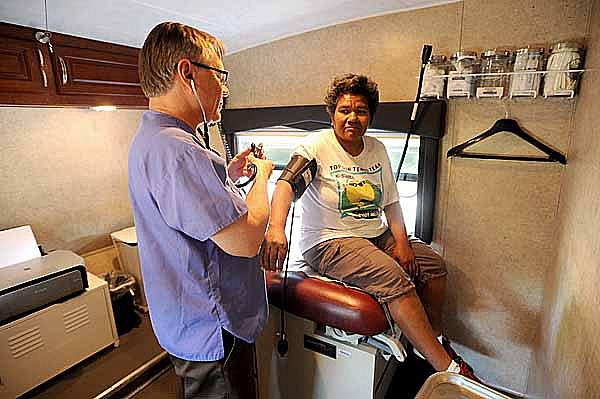Mobile clinic aims to help with chronic diseases

CANOGA PARK - The man known around the Northeast Valley as "el doctor Glenn" hauls a hulking fifth wheel trailer into a church parking lot and prepares for the evening ahead.
He unreels an awning, slides open windows, turns on his laptop and changes into scrubs.
Welcome to mobile health care. The doctor will see you now.
"I'm the truck driver, I scrub the floors, and I can check your liver," said Dr. Glenn Lopez, an assistant professor at UCLA's Department of Family Medicine.
For years, Lopez has dreamed of this moment. Short of making house calls, his one-stop-shop mobile clinic comes as close as he can to bringing basic care to a community that most often doesn't see a doctor until it's too late.
"You'd be surprised what we can do with a weight scale, a blood pressure machine, a urine test stick, a glucometer, and good will," said Lopez one recent day.
Since he unveiled his mobile unit in July, he has quietly served 600 residents in 11 locations around the San Fernando Valley. Today he and Providence Health & Services and the Health Net Foundation will formally announce their collaboration, including a $200,000 grant from Health Net that will allow him to expand locations and continue services for two years.
"Part of our mission is to take care of the poor and vulnerable," said Larry Bowe, chief executive at Providence Holy Cross Medical Center. "This is the kind of thing that has to be done in this country. These are the kind of things we are looking to do."
For those at the Health Net Foundation, collaborating with Lopez was a natural fit, said Ana Andrade, vice president of the corporate social responsibility program at the Health Net Foundation.
"We hope this program will improve access, but also encourage patients to adopt healthy habits," Andrade said.
Lopez cautions he doesn't run a medical clinic. Patients make an appointment at (818) 433-9204 and pay $15 for a consultation. They then schedule follow-ups.
His goal is to help uninsured patients manage chronic illnesses such as diabetes and asthma, and steer their behaviors toward a healthier lifestyle, such as a better diet and more exercise.
In the San Fernando Valley, 7 percent of all adults suffer from diabetes, while nearly 30 percent have high cholesterol. Nearly 40 percent are considered obese, according to Los Angeles County figures, based on data from 2007.
Lopez noticed the daunting statistics when he first came to study health disparities in Sun Valley a decade ago, and learned that obesity and asthma were keeping people inside their homes.
Home to more than 70,000 people, Sun Valley includes clusters of auto dismantlers, junkyards, defunct landfills, recycling facilities and gravel pits - all ingredients for pollution and asthma and a reason for many to stay indoors.
Nearly one-third of the population in Sun Valley and more than 80 percent of children come from working-class families living well below the poverty line.
So Lopez started walking groups that, little by little, drew hundreds of residents almost each evening. He saw that while residents lost weight, they also shared issues on their minds with neighbors they lived side by side with for years, but had never met. The program became so popular that it was replicated in other Valley communities.
Lopez, who worked for 10 years to set up more than 90 clinics in Guatemala, said he learned that a community can come together and do more than just clean up graffiti or thwart crime. A community can drive each member toward wellness
"Everyone lives in a neighborhood, and their greatest asset is their collaborative knowledge and their ability to support each other," he said.
On a recent day, Lopez brought his clinic to the parking lot of the Canoga Park Presbyterian Church, where Rosa Woods climbed aboard the 34-foot-long clinic for a follow-up consultation.
The 46-year-old woman's cholesterol and blood pressure had reached "at risk" levels several months back. Lopez prescribed medication, exercise and a few tips on how to cook with less grease.
As Woods entered the examination room at the front of the trailer, several other ladies climbed into the clinic, where Lopez's assistants, Veronica Camacho and Freyman Recinos weigh them and chat about why they need to see the doctor.
"I had chest pain. I was in the hospital for eight days," one woman told Camacho. "I didn't know I had diabetes, or high blood pressure."
She said it was difficult to go on a diet, especially since she enjoys foods with flavor, or "con grasa," or made with grease.
"I make tortillas with milk and butter, and eat them with butter on them," the woman said. "I can eat five like that."
Just then, Lopez slid open the examination room door and Woods exited with a victorious grin on her face.
"My cholesterol is down and I don't need medication anymore," Woods said in Spanish to the other patients. "And I've lost weight!"
Woods said she learned to remove the fat and skin from chicken when she cooks, and she walks more.
The other women listened, hopeful that they too will one day be able to alleviate some pain and fear.
"Ay Rosa, I'm going to start walking with you," one woman told Woods.
It's one of those interactions that makes Lopez smile.
"This is what we call sparkling moments," Lopez said. "We try to generate these sparkling moments where people learn how and what it takes to make them change their behaviors.
"We all have a difficult time making those difficult changes, but when we encounter others voicing frustrations then support, it makes those changes possible."

